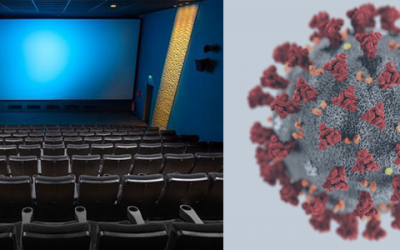Photo credit: NPR, Niko Tavernise/Courtesy of Warner Bros. Pictures
Later this year, World Wide Motion Pictures will release the documentary “Dancers (Danzantes)” for people around the world to experience. Directed by Spanish director Juan Vicente Chuliá, this film takes viewers across the globe to show how people from various backgrounds incorporate the art of dance in their lives, and how dancing can have a major impact on the world around them. Indeed, dancing is a tradition as old as civilization itself, and nowhere is its influence more prominent than in the art of cinema. For as long as the moving image has been a staple of modern culture, it has been used as a tool to capture dancing at its finest. There are more than enough iconic dance scenes in film to discuss at great length, but in the end, we can only talk about a small handful. So without further ado, here are some of our favorite dance scenes brought to us by the world of cinema.
Singin’ in the Rain – Singin’ in the Rain (1952) – of the many icons of the Golden Age of Hollywood, there is nobody more fondly associated with the art of dance than Gene Kelly. While films like An American in Paris and Anchors Aweigh prove that he is rivaled by few as a genuine triple threat (having mastered acting, singing, and dancing), it’s this 1952 musical classic that shows Kelly at the highest point in his career. There are many moments from this film that have deservingly withstood the test of time, but it’s the titular musical number that stands out above the rest. A perfect representation of happiness in the dreariest of conditions, the only thing more infectious than its earworm of a tune is the delightful dance routine Kelly creates for it.
Saraghina, La Rumba! – 8 ½ (1963) – taking place in the memory of Guido, the film’s leading character (and stand-in for director Federico Fellini), this scene reflects on a moment from Guido’s past, in which he dances with the local prostitute Saraghina, only to be berated by the leaders of his Catholic school. One of his first experiences with a woman (one of many more to come over the course of his life), this scene serves as an encapsulation of Guido’s youth and the immaturity he could afford to take part in before the reality of growing up could start to sink in. It’s a brief moment that ends on an unhappy note, but such an abrupt ending only reminds the now adult Guido how much he has lost since he began his transition into adulthood.
More Than a Woman – Saturday Night Fever (1977) – when a dance competition is a major plot point in a movie, then one expects to see some impressive movement coming from the dance floor, and in the case of this 1970’s disco drama, the dancers do not disappoint. Dancing to the Bee Gees’ “More Than a Woman” (one of many of the group’s tunes featured throughout the film), main character Tony (played by John Travolta in his breakout role) and his partner Stephanie give us a performance that is slow, but sensual and full of passionate, and while Tony may feel as if they didn’t deserve the win, it’s not hard to see how the two ended up winning the competition. Disco may be dead, but this scene continues to live on in our hearts.
Saloon Dance – The Muppet Movie (1979) – nothing says friendship like putting on a quick dance routine to entertain the masses, and in the case of Kermit the Frog and Fozzie Bear, this was only the beginning. After Fozzie’s initial stand-up act falls flat, Kermit joins the bear on the stage, and the two engage in a simple tap dance performance. While the crowds in the El Sleazo Cafe remain unimpressed, the same cannot be said for the audience on the other side of the fourth wall. While the technical feats pulled off to create this scene are impressive, it’s the faith that these newfound friends have in each other that truly captures our hearts. This was the beginning of a beautiful friendship, the first of many to form throughout the Muppets’ journey.
Baby and Johnny – Dirty Dancing (1987) – to list our favorite dances in film and not bring up this iconic moment is almost unthinkable, and looking back on this scene, it’s not hard to understand why it’s left such a phenomenal impact. Much of the preceding film is devoted to the main characters training to perfect the dance to end all dances, and through their time together, the romance that blossoms between the two. Despite the ups and downs that occur, by the time Johnny heroically declares “nobody puts Baby in the corner”, it’s only a matter of time for them to deliver the ultimate payoff. Sure enough, they perform their dance to great success, and when Johnny holds Baby in mid-air, there’s no doubt that pure perfection has been achieved.
Dance Finale – Beau Travail (1999) – out of context, this scene of protagonist Sergeant Galoup dancing to Corona’s “The Rhythm of the Night” is engaging enough on its own (if only due to how well actor Denis Lavant is able to pull off the moves shown). In the greater context of the overall film, however, it is an ironic ending to a story plagued with tragedy. Plagued by military service in Djibouti, repressed homosexual feelings, and eventual dismissal from the French Legion, Galoup is left with nothing more to lose. As Galoup holds a loaded gun right before the film cuts to him dancing, the meaning of this juxtaposition is ambiguous. Is the dance real? A metaphor for his final moments? Either way, it’s a perfect end to a tragic narrative.
Snow Dance – Memoirs of a Geisha (2005) – before Frozen took the world by storm with its own winter-centric song and dance, musical legend Rob Marshall gave the world this chilling (metaphorically and literally), but beautiful moment that embodies the struggles and hardships of its central figure, the geisha Sayuri. Starting slow and graceful, but soon becoming sporadic and brutal, the dance symbolizes Sayuri’s life as a geisha, with her wailing and flailing showing her descent into insanity, one brought upon by her determination to wait for a lover she knows will never return. Zhang Ziyi’s Golden Globe nominated acting and Oscar-winning costuming only add greater artistic integrity to this gorgeous, but haunting performance.
Bathroom Dance – Joker (2019) – at the most recent Academy Awards, this supervillain origin story received two awards: one for Best Actor (Joaquin Phoenix), the other for Best Original Score (Hildur Guðnadóttir). To understand how both wins were achieved, all one needs to do is watch this one scene. The starting point of protagonist Arthur Fleck’s descent into darkness, this scene mixes Phoenix’s authentic acting with Guðnadóttir’s somber score to capture a dance that beautifully reflects the beginning of a harrowing transformation. While the Joker’s stair descent dance to the tune of Gary Glitter’s “Rock and Roll, Part 2” may be more iconic (and imitated), it’s this earlier scene that leaves the more significant emotional impact.




